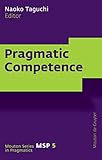Pragmatic Competence / ed. by Naoko Taguchi.
Material type: TextSeries: Mouton Series in Pragmatics [MSP] ; 5Publisher: Berlin ; Boston : De Gruyter Mouton, [2009]Copyright date: ©2009Description: 1 online resource (364 p.)Content type:
TextSeries: Mouton Series in Pragmatics [MSP] ; 5Publisher: Berlin ; Boston : De Gruyter Mouton, [2009]Copyright date: ©2009Description: 1 online resource (364 p.)Content type: - 9783110218541
- 9783110218558
- 495.6/5 22
- PL524.85 .P73 2009eb
- online - DeGruyter
- Issued also in print.
| Item type | Current library | Call number | URL | Status | Notes | Barcode | |
|---|---|---|---|---|---|---|---|
 eBook
eBook
|
Biblioteca "Angelicum" Pont. Univ. S.Tommaso d'Aquino Nuvola online | online - DeGruyter (Browse shelf(Opens below)) | Online access | Not for loan (Accesso limitato) | Accesso per gli utenti autorizzati / Access for authorized users | (dgr)9783110218558 |
Frontmatter -- Contents -- (Instead of a) Foreword -- Pragmatic competence in Japanese as a second language: An introduction -- From a! to zo: Japanese pragmatics and its contribution to JSL/JFL pedagogy -- Indexing stance in interaction with the Japanese desu/masu and plain forms -- Advanced learners’ honorific styles in emails and telephone calls -- Subjectivity and pragmatic choice in L2 Japanese: Emulating and resisting pragmatic norms -- Requesting in Japanese: The effect of instruction on JFL learners’ pragmatic competence -- Influence of learning context on L2 pragmatic realization: A comparison between JSL and JFL learners’ compliment responses -- Refusals in Japanese telephone conversations -- Comprehending utterances in Japanese as a foreign language: Formulaicity and literality -- Comprehension of indirect opinions and refusals in L2 Japanese -- Blended learning for Japanese reactive tokens: Effects of computer-led, instructor-led, and peerbased instruction -- Development of the use of Japanese sentence-final particles through email correspondence -- Commentary: The social turn in second language acquisition and Japanese pragmatics research: Reflection on ideologies, methodologies and instructional implications -- Backmatter
restricted access online access with authorization star
http://purl.org/coar/access_right/c_16ec
In the disciplines of applied linguistics and second language acquisition (SLA), the study of pragmatic competence has been driven by several fundamental questions: What does it mean to become pragmatically competent in a second language (L2)? How can we examine pragmatic competence to make inference of its development among L2 learners? In what ways do research findings inform teaching and assessment of pragmatic competence? This book explores these key issues in Japanese as a second/foreign language. The book has three sections. The first section offers a general overview and historical sketch of the study of Japanese pragmatics and its influence on Japanese pedagogy and curriculum. The overview chapter is followed by eight empirical findings, each dealing with phenomena that are significant in Japanese pragmatics. They target selected features of Japanese pragmatics and investigate the learners' use of them as an indicator of their pragmatic competence. The target pragmatic features are wide-ranging, among them honorifics, speech style, sentence final particles, speech acts of various types, and indirect expressions. Each study explicitly prompts the connection between pragmalinguistics (linguistic forms available to perform language functions) and sociopragmatics (norms that determine appropriate use of the forms) in Japanese. By documenting the understanding and use of them among learners of Japanese spanning multiple levels and time durations, this book offers insight about the nature and development of pragmatic competence, as well as implications for the learning and teaching of Japanese pragmatics. The last section presents a critical reflection on the eight empirical papers and prompts a discussion of the practice of Japanese pragmatics research.
Issued also in print.
Mode of access: Internet via World Wide Web.
In English.
Description based on online resource; title from PDF title page (publisher's Web site, viewed 28. Feb 2023)


